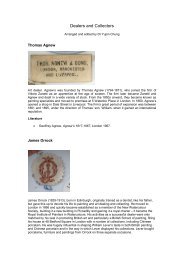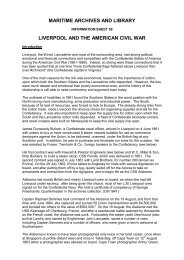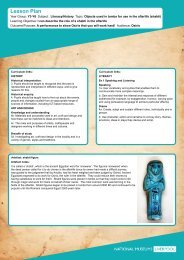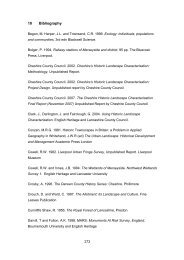Emigration-Emigration to USA and Canada no13.pdf - National ...
Emigration-Emigration to USA and Canada no13.pdf - National ...
Emigration-Emigration to USA and Canada no13.pdf - National ...
- No tags were found...
You also want an ePaper? Increase the reach of your titles
YUMPU automatically turns print PDFs into web optimized ePapers that Google loves.
MARITIME ARCHIVES & LIBRARYINFORMATION SHEET 13EMIGRATION TO <strong>USA</strong> AND CANADA<strong>Emigration</strong> <strong>to</strong> the Americas began as early as 1585, but the first successful settlement wasnot established until James<strong>to</strong>wn in 1607, with perhaps the most famous subsequent arrivalsbeing that of the Mayflower from Plymouth in 1620 carrying a party of Puritans. Emigrantsalso went <strong>to</strong> work on the <strong>to</strong>bacco plantations in Virginia, many as indentured servants of theplantation owners. The Americas were also Britain's first penal colony, with many thous<strong>and</strong>sof men, women <strong>and</strong> children from Engl<strong>and</strong>, Scotl<strong>and</strong>, Wales <strong>and</strong> Irel<strong>and</strong> sentenced <strong>to</strong>transportation in the 17 th <strong>and</strong> 18 th centuries. Although the sentences were usually only for 7or 14 years, many would never be able <strong>to</strong> return home.Transportation <strong>to</strong> America ended with the American War of Independence in 1776, butemigration <strong>to</strong> America <strong>and</strong> <strong>Canada</strong> continued throughout the 19 th <strong>and</strong> 20 th centuries.<strong>Canada</strong> became the main British colony for transportation <strong>and</strong> emigration, particularly childmigration with some 80,000 child emigrants from the UK between 1870 <strong>and</strong> 1914 (seeInformation Sheet 10, Child Migration).Between 1830 <strong>and</strong> 1930 over nine million emigrants sailed from Liverpool bound for a newlife in the "New World" countries such as the United States, <strong>Canada</strong> <strong>and</strong> Australia. Formuch of this period Liverpool was the most popular port of departure for emigrants fromEurope <strong>to</strong> the Americas <strong>and</strong> <strong>Canada</strong> because she already had well established transatlanticlinks based on the import of cot<strong>to</strong>n <strong>and</strong> timber. Liverpool was also well placed <strong>to</strong> receive themany emigrants from the countries of north western Europe, who would cross the North Sea<strong>to</strong> Hull <strong>and</strong> then travel <strong>to</strong> Liverpool by train. Liverpool's share of the emigrant trade began <strong>to</strong>decline from the late 19 th century as emigrants increasingly came from the countries ofsouthern <strong>and</strong> eastern Europe, <strong>and</strong> although some passed through Liverpool, most sailedfrom the nearer German <strong>and</strong> Italian ports. In addition, in the early years of the 20 th centurySouthamp<strong>to</strong>n became the main departure port for Cunard liners <strong>and</strong> other ships sailing <strong>to</strong>America.There were three main motives for emigration. Some of the emigrants were fleeing from thehardships of poverty <strong>and</strong> unemployment, for example, the 1,250,000 Irish who emigratedbetween 1845 <strong>and</strong> 1851 as a result of the pota<strong>to</strong> famine. For Russian <strong>and</strong> Polish Jews,emigration was a way of escaping from political <strong>and</strong> religious persecution. Other emigrantswere not suffering the hardships of poverty or the terror of persecution, but were attracted bythe possibility of a higher st<strong>and</strong>ard of living in the United States, <strong>Canada</strong> <strong>and</strong> elsewhere inthe "New World". The "Gold Rush" in America <strong>and</strong> Australia also encouraged people <strong>to</strong>emigrate <strong>to</strong> make their fortunes.Emigrants could often spend from one <strong>to</strong> ten days or more, waiting for their ship in aLiverpool lodging house. In the late 1840s <strong>and</strong> 1850s, lodging houses were ofteninhospitable, dirty <strong>and</strong> overcrowded. In the mid19 th century emigrants passing throughLiverpool were also subject <strong>to</strong> harassment <strong>and</strong> fraud by local confidence tricksters, known as'runners', who would frequently snatch emigrants' luggage <strong>and</strong> would only return it uponpayment of a large fee.From the 1860s the situation began <strong>to</strong> improve as steam started <strong>to</strong> replace sail on theAtlantic route. The steamship companies started <strong>to</strong> look after the emigrants during their stayin Liverpool with their representatives meeting them upon arrival in Liverpool, <strong>and</strong> takingthem <strong>to</strong> lodging houses which were often owned by the steamship companies.
Until the early 1860s most emigrants left Liverpool on a sailing ship. The voyage <strong>to</strong> theUnited States <strong>and</strong> <strong>Canada</strong> <strong>to</strong>ok about thirty five days. Most emigrants travelled in thecheapest class of accommodation, known as the steerage. This was similar <strong>to</strong> a dormi<strong>to</strong>rywith bunks down the sides <strong>and</strong> tables in the centre. It was frequently overcrowded with poorventilation. Emigrating in a sailing ship could be unpleasant, particularly during a s<strong>to</strong>rm.Seasickness was a particular problem on the s<strong>to</strong>rmy North Atlantic westbound voyage, <strong>and</strong>diseases such as cholera <strong>and</strong> typhus frequently reached epidemic proportion as infectionspread throughout the confined decks. Scores of emigrants died from these diseases.Conditions improved following the 1855 Passenger Act which laid down minimum st<strong>and</strong>ardsfor rations, space <strong>and</strong> sanitation.By 1870 virtually all emigrants <strong>to</strong> the United States <strong>and</strong> <strong>Canada</strong> went by steamship <strong>and</strong> thevoyage was consequently reduced <strong>to</strong> between seven <strong>and</strong> ten days. Competition betweenthe steamship companies helped, <strong>to</strong> some extent, <strong>to</strong> improve conditions for the emigrants,<strong>and</strong> from about 1900, thirdclass cabins began <strong>to</strong> replace the steerage accommodation.Emigrants made a variety of new lives for themselves in the United States <strong>and</strong> <strong>Canada</strong>,finding work on farms, in industry <strong>and</strong> building railways. Some fared no better or even worsethan at home, <strong>and</strong> often returned home if they could afford <strong>to</strong> do so.RecordsOfficial lists of passengers arriving in <strong>USA</strong> <strong>and</strong> <strong>Canada</strong>, are <strong>to</strong> be found in the appropriatenational archives. No official lists of passengers exist in any local reposi<strong>to</strong>ries in the UK (seeInformation Sheet 31, Passengers on Board Ship). The <strong>National</strong> Archives (PRO), RuskinAvenue, Kew, Richmond, Surrey, TW9 4DU, holds Board of Trade passenger lists of vesselstravelling inwards <strong>to</strong> <strong>and</strong> outwards from British ports, including Liverpool, from the 1890s <strong>to</strong>1960 (BT 26, 27 <strong>and</strong> 32). The outward list BT 27 is now available online atwww.findmypast.com. Inward passenger lists from 1878 <strong>to</strong> 1960 are also available online atwww.ancestry.co.uk/search/db.aspx?dbid=1518.Some passenger lists for Cunard Line from 18401853 survive in the Liverpool UniversityCunard Archives, but these do not cover emigrant steerage passengers until 1860.The Maritime Archives & Library has a significant collection of emigrant diaries, letters,pho<strong>to</strong>graphs <strong>and</strong> examples of passage tickets <strong>and</strong> guides in its DX/SAS collections.No permission, passport or application form was necessary, in order <strong>to</strong> emigrate from GreatBritain or Irel<strong>and</strong> in the 19 th century. Only when financial assistance, from or via thegovernment, was required, did forms of application have <strong>to</strong> be completed. There were manyassisted emigrants <strong>to</strong> Australia <strong>and</strong> New Zeal<strong>and</strong> in the 19 th century, also <strong>to</strong> <strong>Canada</strong>,especially in the early 20 th century. There were a number of private emigration schemes <strong>to</strong><strong>USA</strong>, but none had government backing since they did not contribute <strong>to</strong> British interests inwhat later became the Empire, <strong>and</strong> later still, the Commonwealth. Records of theseschemes do not seem <strong>to</strong> have survived in the <strong>National</strong> Archives.There are no records of the shipping company hostels or boarding houses. If people stayedover a census night they might be recorded but one would need <strong>to</strong> know the address of thehostel first.
The line prospered after the war but passenger traffic declined in the 1960s, leading <strong>to</strong> achange from regular transatlantic services <strong>to</strong> cruising only, <strong>and</strong> <strong>to</strong> entry in<strong>to</strong> the AtlanticContainer Lines consortium for cargo services in 1966. In 1971 it was taken over byTrafalgar House Investments Ltd., which continue <strong>to</strong> own cruise ships, including QueenElizabeth 2 <strong>and</strong> Caronia.RecordsShip plans <strong>and</strong> records from the naval architect's <strong>and</strong> marine engineer's offices <strong>and</strong> a richcollection of printed ephemera in the SAS <strong>and</strong> DX miscellaneous collections includingmenus, postcards <strong>and</strong> souvenir brochures. Cunard archives are held at Liverpool UniversityArchives.Dominion LineThis company was formed in 1870 as the Liverpool <strong>and</strong> Mississippi Steamship Co. Itexp<strong>and</strong>ed its services <strong>to</strong> include Quebec <strong>and</strong> Montreal in 1872, changing its name <strong>to</strong> theMississippi <strong>and</strong> Dominion Steamship Co., abbreviated <strong>to</strong> Dominion Line. Emigrants <strong>to</strong><strong>Canada</strong> comprised the bulk of its weekly service <strong>to</strong> Quebec <strong>and</strong> Montreal, calling at Irishports en route. The company was bought by IMM in 1902 <strong>and</strong> from 1909 until 1926 theCanadian trade was maintained as a joint service with White Star.RecordsPapers relating <strong>to</strong> Henry Eves of the SS Ot<strong>to</strong>man, for rescuing crew from the Dutchschooner Anna, including a letter from Dominion Lines, re the incident, SAS/23A/2/15Passenger list for RMS Vancouver, Montreal <strong>to</strong> Liverpool via Londonderry, 1899, DX/2055Guion LineStephen Guion, partowner of the New YorkLiverpool Old Black Star Line of sailing packets<strong>and</strong> manager of Cunard's emigrant business (18621866), set up his own steamship line,Liverpool <strong>and</strong> Great Western Steamship Co. or Guion Line, in 1866. Guion's death in 1885,poor traffic <strong>and</strong> the high cost of its big fast ships led <strong>to</strong> its winding up in 1894.RecordsGuidebook, Liverpool, London, Paris, 1875, SAS/33F/3/3Ticket for passage <strong>to</strong> New York on Arizona, 1892, B/AW/22Poster, c.1890, DX/596Plan of the Oregon, 1882, Cunard collectionInman LineFounded in 1850 by Richardson Brothers & Co., with William Inman as partner, the InmanLine was the first steamship line <strong>to</strong> carry steerage passengers. Despite the loss of two ships<strong>and</strong> 480 passengers <strong>and</strong> crew in 1854 <strong>and</strong> the suspension of transatlantic sailings in favourof war work, 18541856, the line prospered <strong>and</strong> exp<strong>and</strong>ed. From 1871 intense competition,especially from the White Star Line, <strong>and</strong> increased shipbuilding costs caused problems. In1886 the line was sold <strong>to</strong> the American International Navigation Co., owners of the American<strong>and</strong> Red Star Lines. This eventually led <strong>to</strong> American ownership in 1892 <strong>and</strong> the shift of theBritish terminus <strong>to</strong> Southamp<strong>to</strong>n in 1893.RecordsFinancial Papers, etc., re the formation of Inman Steamship Co., Ltd., D/SO/7/1/40Poster advertising the company's services <strong>to</strong> emigrants, 1874, in the Bryson Collection,D/B/115GG
The Alsop Wilkinson Marine Solici<strong>to</strong>rs collection contains Financial Agreements, Deeds ofCovenants, etc., between the Inman Steam Ship Co., Ltd. <strong>and</strong> Barrow Shipbuilding Co., rerepairs <strong>to</strong> the City of Rome, 18841887, <strong>and</strong> agreements as <strong>to</strong> agency between the InmanSteam Ship Co. <strong>and</strong> the International Navigation Co., Ltd., 1885, B/AW/29<strong>National</strong> LineFounded in Liverpool in 1863, the <strong>National</strong> Steam Navigation Co., Ltd., concentrated on afleet of large ironscrew steamers for the cargo <strong>and</strong> emigrant trade from Liverpool <strong>to</strong> NewYork. In 1867 it was reorganised <strong>to</strong> meet the challenge of the new Guion Line set up by itsformer passenger agent. The policy of capacity rather than speed was pursued, <strong>and</strong> in 1870the line carried 33,500 steerage passengers <strong>and</strong> 395,000 <strong>to</strong>ns of cargo, which put it aheadof Cunard, Guion <strong>and</strong> Anchor, <strong>and</strong> just behind Inman. However, the line stagnated in thelate1870s despite several attempts <strong>to</strong> establish new services <strong>and</strong> although the years 18871889 were reasonably profitable, there was a drop in traffic in 1890 <strong>and</strong> a loss of two ships insix months. The Liverpool passenger service was ended <strong>and</strong> replaced with a cargoonlyLondonNew York service. The Line was bought by the Atlantic Transport Line in 1896 <strong>and</strong>operated separately until its disappearance in 1914.RecordsSailing Bills for the <strong>National</strong> Line's LiverpoolNew York service, c.1870, SAS/33F/3/9.Advertisements for sailing, c.18751880, SAS/33F/3/1.Bryson Collection includes a Direc<strong>to</strong>r's report <strong>and</strong> statement of accounts, 1872; resolution ofthe Board, re an agreement made between Atlantic trade competi<strong>to</strong>rs, 1875; <strong>and</strong> sharetransfer certificates <strong>and</strong> dividends, 18731875, D/B/115.White Star LineThomas Ismay, sailing shipowner <strong>and</strong> a direc<strong>to</strong>r of the <strong>National</strong> Line, bought the name <strong>and</strong>goodwill of the defunct White Star Line of Australian sailing packets in 1867. In 1868, he setup the Ocean Steam Navigation Co., Ltd., which was known as the White Star Line. Sailingsstarted in 1870 <strong>and</strong> were an immediate success. It strengthened its position by a trafficsharingagreement with the Inman Line. Ismay, Imrie & Co., the managers, also ran a flee<strong>to</strong>f large iron <strong>and</strong> steel sailing ships until 1895. In 18881889 it began <strong>to</strong> buy cargo <strong>and</strong> cattlesteamers as well as large luxurious passenger liners of moderate speed, a policy whichultimately led <strong>to</strong> the 45,000<strong>to</strong>n sisters Olympic, Titanic <strong>and</strong> Britannic. Thomas Ismay died in1899 <strong>and</strong> in 1902 his creation was sold <strong>to</strong> the International Mercantile Marine. Its Britishmanagement <strong>and</strong> registry was retained; services with other British lines in the IMM, such asDominion, were rationalised <strong>and</strong> the "main line" service was moved in 1907 from Liverpool <strong>to</strong>Southamp<strong>to</strong>n from where the illfated Titanic left on its maiden voyage in April 1912. In 1926it was purchased by Lord Kylsant, whose subsequent crash caused the merger with Cunardin 1934. The mo<strong>to</strong>r ships Britannic (1930) <strong>and</strong> Georgic (1932) were retained on theLiverpoolNew York service.RecordsBryson CollectionMonthly office accounts of J.B. Ismay, 1908 1912.Correspondence, C. McIver, W.S. Graves, T.H. Ismay, re advance for Beaver Line, alsoF.M. Radcliffe (partner in Ayr<strong>to</strong>n, Alderson Smith), 1894 1911.Letters, re the disposal of papers of T.H. Ismay involving members of the family, 1910 1914.Correspondence, Mrs. T.H. Ismay <strong>and</strong> Norman Shaw, architect, re memorial <strong>to</strong> T.H. Ismay,1899 1900.Provisional agreement with J.P. Morgan & Co., re the acquisition of White Star <strong>and</strong> fourother lines, 1902, with correspondence <strong>and</strong> notice of Ordinary General Meeting, 1902.File, re the estate of T.H. Ismay, 1907 1935.
Bills, re White Star offices, 1922 1923.Company pension fund papers, 1938.D/B/174 1863 1963 3 BoxesCorrespondence with P.A.S. Franklin, New York, re the resignation of J. Bruce Ismay fromthe Board of IMM, 1916.Correspondence, J. Bruce Ismay <strong>to</strong> the Lord Mayor of Liverpool, re the extension ofLiverpool Seamen's Pension Fund (founded by T.H. Ismay) <strong>to</strong> provide for seamen's widows,1912.Letter from Chief Engineer of Olympic, re maiden voyage , 1911, with other letters includingone on the coal situation affecting the speed of Olympic <strong>and</strong> Titanic.Correspondence, P.A.S. Franklin, J. Bruce Ismay, Captain E.J. Smith of the Olympic, etc., reOlymic <strong>to</strong> show that J. Bruce Ismay was opposed <strong>to</strong> fast running of steamers, 1911.DX/504 1893 1917 1 BoxPlans of White Star liners can be found in the Cunard ship plan collection.BibliographyMORTON, Allan. Direc<strong>to</strong>ry of European Passenger Steamship Arrivals. Baltimore:Genealogical Publishing, 1987.READ, G. & REES, P. The Leaving of Liverpool. Liverpool: <strong>National</strong> Museums Liverpool,1986.COLEMAN, T. Passage <strong>to</strong> America. London: Penguin, 1972.ERICKSON, C. Invisible Immigrants. Leicester: Leicester University Press, 1972.GUILLET, E.C. The Great Migration, 17701860. Toron<strong>to</strong>: University of Toron<strong>to</strong>, 1963.JONES, M.A., Destination America. London: Thames T.V., 1976.MADDOCKS, M. The Atlantic Crossing. Alex<strong>and</strong>ria, <strong>USA</strong>: TimeLife, 1981.TEPPER, M. American Passenger Arrival Records. Baltimore: Genealogical PublishingCompany, 1988.THRELFALL, Helen. <strong>Emigration</strong> A Bibliography of Works in the English Language held bythe Maritime Archives & Library. Liverpool: <strong>National</strong> Museums Liverpool, 1996.Useful Addresses<strong>Canada</strong> <strong>National</strong> & Provincial Archives<strong>National</strong> Archives of <strong>Canada</strong>, 395 Welling<strong>to</strong>n Street, Ottawa, Ontario, K1A 0N3 www.archives.caProvincial Archives of Alberta12845102 AvenueEdmon<strong>to</strong>nAlberta T5N 0M6Public Archives of Nova Scotia6016 University AvenueHalifaxNova Scotia B3H 1W4
Provincial Archives of British Colombia655 Belleville StreetVic<strong>to</strong>riaBritish Colombia V8V 1X4Provincial Archives of Mani<strong>to</strong>ba220 Vaughan StreetWinnipegMani<strong>to</strong>ba R3C 0P8Provincial Archives of New BrunswickPO Box 6000Federic<strong>to</strong>nNew Brunswick E3B 5H1Provincial Archives of Newfoundl<strong>and</strong> <strong>and</strong>LabradorColonial BuildingMilitary RoadSt. John'sNewfoundl<strong>and</strong> A1C 5T7Archives of the Northwest Terri<strong>to</strong>riesPrince of WalesNorthern Heritage CentreYellowknifeNorthwest Terri<strong>to</strong>ries X1A 2L9Archives of Ontario77 Grenville StreetQueen's ParkToron<strong>to</strong>Ontario M7A 2R9Public Archives of Prince Edward Isl<strong>and</strong>PO Box 7000Charlotte<strong>to</strong>wnPrince Edward Isl<strong>and</strong> C1A 7M4Archives <strong>National</strong>es de QuebecPO Box 10450SainteFoyQuebec G1V 4N1Saskatchewan Archives BoardRegina OfficeUniversity of ReginaReginaSaskatchewan S4S 0A2Yukon Terri<strong>to</strong>ry ArchivesPO Box 2703WhitehorseYukon Terri<strong>to</strong>ry Y1A 2C6<strong>USA</strong> <strong>National</strong> Archives Regional System<strong>National</strong> Archives & Records Service (NARS) General Services Administration, PennsylvaniaAvenue, Washing<strong>to</strong>n, DC 20408www.archives.gov<strong>National</strong> Archives New Engl<strong>and</strong> Region380 Trapelo RoadWaltham, MA 02154Tel: 617 647 8100(Connecticut, Maine, Massachusetts, NewHampshire, Rhode Isl<strong>and</strong>, Vermont)<strong>National</strong> Archives South West RegionPO Box 6216501 West Felix StreetForth Worth, TX 76115Tel: 817 334 5525(Arkansas, Louisiana, New Mexico*, Oklahoma,Texas)(*Most records from Federal Agencies in NewMexico are at the Rocky Mountain Range)<strong>National</strong> Archives Pittsfield Region100 Dan Fox DrivePittsfield, MA01201Tel: 413 445 6885(Microfilm only)<strong>National</strong> Archives North East Region201 Varick StreetNew York, NY10014Tel: 212 337 1300(New Jersey, New York, Puer<strong>to</strong> Rico, the VirginIsl<strong>and</strong>s)<strong>National</strong> Archives Rocky Mountain RegionBuilding 48, Denver Federal CenterDenver, CO 802250307Tel: 303 236 0817(Colorado, Montana, North Dakota, SouthDakota, Utah, Wyoming, New Mexico(see * above)<strong>National</strong> Archives Pacific South West Region24000 Avila RoadLaguna Niguel, CA 92656Tel: 714 643 4241(Arizona, Southern California <strong>and</strong> Clark County,Nevada)
<strong>National</strong> Archives MidAtlantic Region9 th <strong>and</strong> Market Streets, Room 1350Philadelphia, PA 19107Tel: 215 597 3000(Delaware, Maryl<strong>and</strong>, Pennsylvania, Virginia,West Virginia)<strong>National</strong> Archives South East Region1557 St. Joseph AvenueEast Point, GA 30344Tel: 404 763 7477(Alabama, Florida, Georgia, Kentucky,Mississippi, North Carolina, South Carolina,Tennessee)<strong>National</strong> Archives Great Lakes Region7358 South Pulaski RoadChicago, IL 60629Tel: 312 581 7816(Illinois, Indiana, Michigan, Minnesota, Ohio,Wisconsin)<strong>National</strong> Archives Pacific Sierra Region1000 Commodore DriveSan Bruno, CA 94066Tel: 415 876 9009(Northern California, Hawaii, Nevada (exceptClark County), the Pacific Trust Terri<strong>to</strong>ries,American Samoa)<strong>National</strong> Archives Pacific North West Region6125 S<strong>and</strong> Point Way NESeattle, WA 98115Tel: 206 526 6507(Idaho, Oregon, Washing<strong>to</strong>n)<strong>National</strong> Archives Alaska Region654 West Third AvenueAnchorage, AK 99501Tel: 907 271 2441(Alaska)<strong>National</strong> Archives Central Plains Region2312 East Bannister RoadKansas City, MO 64131Tel: 816 926 6272(Iowa, Kansas, Missouri, Nebraska)The Immigrant Transcribers Guild (<strong>USA</strong>) have recently transcribed a number of British ships'passenger lists. These include over 1,700 for ships departing from Liverpool, 17721929,held at the <strong>National</strong> Archives Records Administration, Washing<strong>to</strong>n D.C.Visit their website at: www.immigrantships.net/Online searchable databases of names of people who passed through Castle Garden <strong>and</strong>Ellis Isl<strong>and</strong>, can be found at: www.castlegarden.org <strong>and</strong> www.ellisisl<strong>and</strong>records.orgInformation on passenger lists, fleet lists <strong>and</strong> ship arrivals, can be found at:www.theshiplist.comA site run by the <strong>National</strong> Archives, <strong>to</strong> guide family his<strong>to</strong>rians <strong>to</strong> relevant sites <strong>to</strong> help withtheir research, can be found at: www.familyrecords.gov.ukThe Irish <strong>Emigration</strong> Database, a computerised collection of primary source documents,including passenger lists, emigrant's letters <strong>and</strong> diaries, etc., on Irish emigration <strong>to</strong> the <strong>USA</strong><strong>and</strong> <strong>Canada</strong> in the 18 th <strong>and</strong> 19 th centuries, is being compiled by the Centre for MigrationStudies at the Ulster American Folk Park, details of which can be found at:www.qub.ac.uk/cmsINFOSHEET13.SSMMM/DOCS/LR/16.2.04 Rev JW 10.08


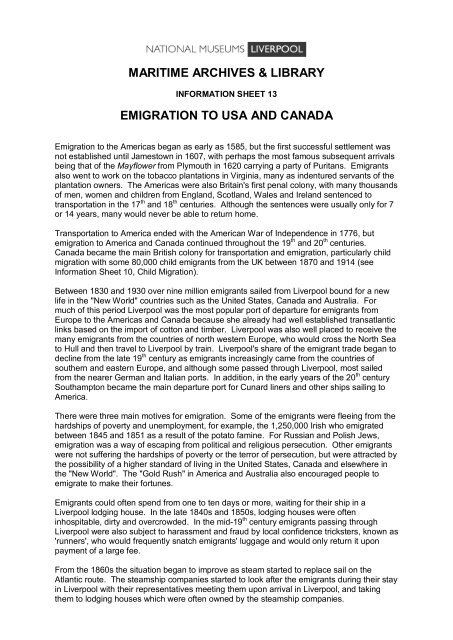
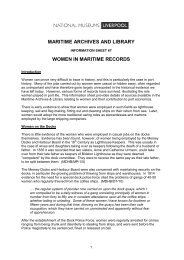
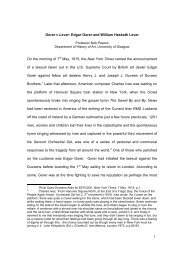
![Ancient Egypt trail [227kb .pdf] - National Museums Liverpool](https://img.yumpu.com/48998817/1/184x260/ancient-egypt-trail-227kb-pdf-national-museums-liverpool.jpg?quality=85)

